The World Health Organization’s response to Covid-19
by Mara Pillinger
MARA PILLINGER is an Associate at the O’Neill Institute for National and Global Health Law, Global Health Policy & Politics Initiative. Her work focuses on HIV policy and global health governance, including the COVID-19 response and the politics of reform at WHO and other global health organizations
! Before you read, download the companion Glossary that includes definitions, a guide to acronyms and abbreviations used in the article, and other material. Go to www.fpa.org/great_decisions and select a topic in the Resources section. (Top right)
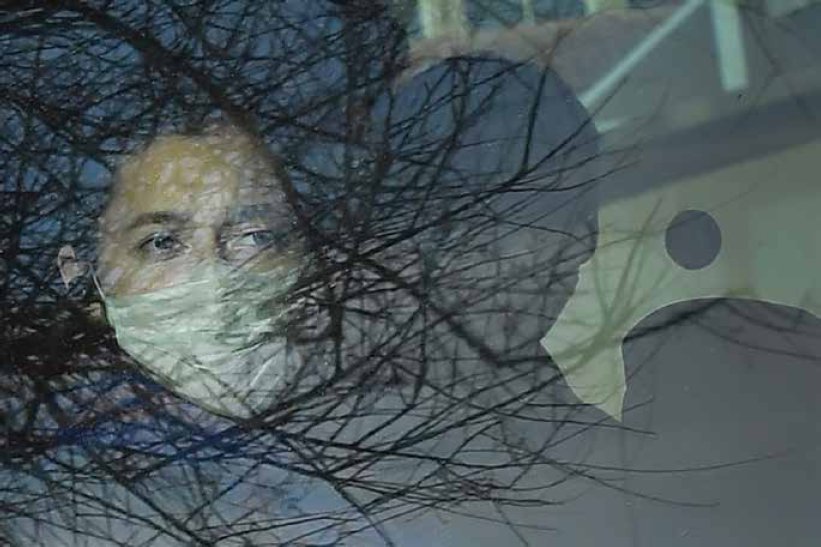
A passenger looks on from a vehicle containing French citizens after their evacuation from the Chinese city of Wuhan, as it arrives in southern France on January 31, 2020, following their repatriation from the coronavirus zone. A plane carrying around 200 French citizens evacuated from the Chinese city of Wuhan, epicentre of the coronavirus outbreak, landed near Marseille, None of the passengers showed symptoms of the virus that prompted the World Health Organization to declare a global emergency. (GERARD JULIEN/AFP/GETTY IMAGES)
On July 7, 2020, President Donald Trump notified the United Nations of his intent to withdraw the U.S. from the World Health Organization (WHO). With the Covid-19 pandemic raging in the U.S. and around the world, the President asserted that WHO had failed in its duty to warn the world early on about the dangers posed by the new coronavirus because the agency and its Director-General, Dr. Tedros Adhanom Ghebreyesus, are too “China-centric”. Administration allies, like Senator Rick Scott (R-FL), accused WHO of “helping Communist China cover up a global pandemic” Leading global health experts have overwhelmingly decried the U.S. decision to withdraw from membership and to withhold financial support from WHO. Pointing to numerous factual inaccuracies in the Trump administration’s account of events, they argue that Trump’s attacks on WHO are a blatant attempt to deflect blame from the administration’s own failures to check the spread of the virus within the U.S. They point out that WHO declared a “public health emergency of international concern” (PHEIC) on January 30, one month after the first reported cases, and at a time when there were only 83 reported cases and no deaths outside China. And they remind critics that Tedros and WHO consistently warned governments to “act now” to urgently escalate social distancing, testing, contact tracing, and isolation in the face of “this very grave threat”—warnings that many governments chose to ignore until it was too late.
Experts also caution that abandoning WHO will undermine U.S. health security and diplomatic goals far beyond Covid-19, damaging long-standing priorities like polio eradication, access to flu vaccines, and the ability to detect and respond to the next pandemic. As Bill Gates put it, “halting funding for [WHO] during a world health crisis is as dangerous as it sounds.” In short, the consensus is that if the U.S. withdraws from WHO, it would be cutting off its nose to spite its face.
But even as global health thought leaders criticize the U.S.’s planned course of action, many also acknowledge that WHO’s early response to Covid-19 was not what it should have been. For example, David Fidler, a leading international lawyer and fellow in global health at the Council on Foreign Relations, told The Guardian that “[y]ou’ve got a situation where it looks like WHO doesn’t want to exercise its authority.” Richard Horton, editor of the prestigious medical journal The Lancet, said that WHO “has been drained of power and resources…. Its coordinating authority and capacity are weak. Its ability to direct an international response to a life-threatening epidemic is non-existent.” These and other experts paint a picture of an agency that was timid when it needed to be bold, unable to compel the Chinese government to share information or rally other governments to act early to stop the coronavirus outbreak before it became a pandemic.
Amid all this back-and-forth, readers looking to understand WHO’s response to Covid-19 should be asking three sets of questions. First, how did we get here? How does WHO work, and what role is it supposed to play in pandemic responses? Second, what is happening now, during Covid-19? What is WHO doing well, and what could/should it do differently, bearing in mind its existing capacities and limitations? Third, where do we go from here? What needs to change in order for WHO to do better in the future? Because for all the uncertainty around the current pandemic, perhaps the only certain thing is that it will not be the last pandemic. Placing blame is a political exercise, but understanding what went right, what went wrong, and how we do better is a necessity for policymakers.
How Did We Get Here? WHO, SARS, and the IHR
Created in 1948, WHO is the specialized agency of the United Nations responsible for global public health. WHO is a Member State organization, comprised of 194 countries. To understand WHO’s response to Covid-19, we first need to familiarize ourselves with its structure and mandate, as well as how the organization is funded and what kinds of limitations it faces.
Structure & governance
WHO has four main structures. First is the World Health Assembly (WHA), a parliamentary body in which Member States come together to conduct health diplomacy, reach policy and international legal agreements, and establish WHO’s programmatic agenda and budget. On paper, WHA operates on a one-state, one-vote principle; in practice, by ironclad tradition, decisions are taken by consensus or not at all. The need to reach consensus among Member States can be a formidable barrier to action, particularly on issues like WHO reform—but at the same time, it works to keep Member States at the table through disagreements, which is essential to WHO’s legitimacy as a long-term diplomatic project and a globally representative body. At the same time, because WHO is an intergovernmental organization in which only states have a vote, the agency has struggled to provide substantive and equal-access opportunities for participation by non-Member States (e.g. Taiwan) and civil society. Second, in addition to the WHA, WHO is governed by an Executive Board comprised of 34 technical experts nominated by their governments. The Executive Board sets the agenda for the WHA and then oversees implementation of WHA decisions.
Third, the Secretariat, led by the Director-General, is WHO’s administrative and executing arm, responsible for carrying out the programmatic agenda set by Member States. Among its other roles, it coordinates the response to global health emergencies, like Covid-19. But importantly, with a few exceptions (like emergencies), the Secretariat is not an implementing agency that oversees or carries out activities on the ground. Instead, it works closely with national Ministries of Health of to provide technical guidance and support through WHO’s regional and country offices.
Fourth, to a degree unique among UN agencies, WHO is a highly decentralized organization, with six regional offices overseeing 150 country offices. These regional offices are highly autonomous, each led by a Regional Director elected by the region’s Member States, governed by its own Regional Assembly, and with command over its own budget. Together, the regional and country offices oversee as much as three quarters of WHO’s staff and more than half its total expenditure. Consequently, there is very little accountability to WHO’s headquarters in Geneva, Switzerland, and, at times, a great deal of tension and competition across levels. On the one hand, this decentralized structure can help foster closer relationships and better coordination with governments. But it can also lead to “pathological fragmentation,” creating inefficiencies, overlaps, and breakdowns in coordination between Geneva and the regional and country leves, which undermines Geneva’s ability to coordinate global action.
Mandate
WHO’s constitution sets out a vast mandate—promoting “the attainment by all peoples of the highest possible level of health”—that essentially covers all health issues, everywhere in the world. The constitution goes on to lay out 22 specific functions for the agency, ranging from the very general (“proposing conventions, agreements, and regulations with respect to international health matters”) to the specific (e.g. “standardizing diagnostic procedures”). Initially, the agency’s focus was very much on infectious diseases. But over time, as the global burden of disease has shifted, our awareness of the need to address various health challenges has evolved, and Member States’ priorities have varied, WHO’s focus has continually expanded to include things like non-communicable diseases, road traffic accidents, addiction, mental health, universal health care, and strengthening of health systems.
More concretely, WHO’s mandate can be broken down into four roles. First, it is a global hub of scientific and technical expertise, gathering and analyzing information, issuing guidelines, providing technical advice and assistance to governments, regulating things like the quality of medicines, and so on. Second, it is a normative agency, setting goals and agendas (e.g. advocating for universal health care as a human right), and drafting and steering the diplomatic negotiations around international health treaties and regulations. Importantly, WHO’s normative activities can be proposed and executed by the Secretariat, but they must be approved by the WHA. Third, WHO is the chief convening and coordinating authority in global health, bringing together the constellation of global health actors—including governments, other multilateral global health institutions, civil society, philanthropic donors, and scientists—to shape policy agendas and technical guidelines. Finally, it is a political venue in which Member States seek to advance their interests. Taken together, WHO’s vast mandate essentially leaves the agency in the position of trying to be all things to all people on all health issues everywhere in the world.
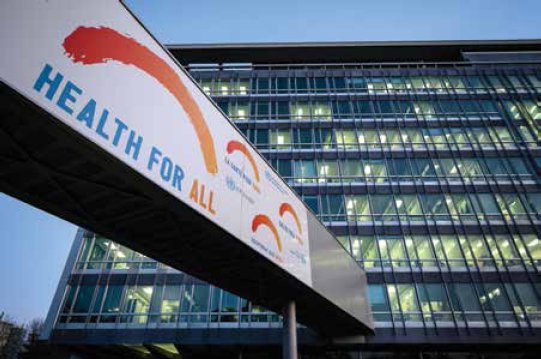
A picture taken on January 12, 2020, shows the World Health Organization (WHO) headquarters prior to a combined news conference following a two-day international conference on Covid-19 coronavirus vaccine research and a meeting to decide whether Ebola in DR Congo still constitutes health emergency of international concern in Geneva.(FABRICE COFFRINI/AFP/GETTY IMAGES)
Financial woes and other limitations
Fulfilling such a mandate would be a challenge even for a powerful and well-resourced organization. WHO is neither. WHO’s budget for 2020–21 is $2.4 billion dollars per year—roughly the budget of a large hospital in a wealthy country and a quarter of the budget for the U.S. CDC. This budget is funded in two ways: mandatory assessed contributions from Member State governments and voluntary contributions from governments and non-governmental donors (e.g. the Bill and Melinda Gates Foundation). The latter are usually earmarked for specific purposes. Since assessed contributions were frozen two decades ago—and since Member States frequently fail to pay those dues on time—WHO has had to increasingly rely on voluntary contributions, which now comprise up to 80% of its budget. Moreover, almost 65% of WHO funding comes from just 15 donors. Consequently, WHO’s funding flow is unstable, subject to the whims of donors, and constrained, leaving the agency unable to make long-term plans or address critical global health issues if they are not donor priorities (e.g. Ebola, prior to 2014). And because most of its funding is not flexible, WHO must launch emergency appeals to be able act in the face of each new crisis, as with Covid-19. Member States recognize that these financial problems hamstring WHO and have taken partial steps to address them—yet prior to Covid-19 they have consistently rejected efforts to implement the basic necessary fix of increasing assessed contributions.
Second, WHO is primarily an advisory and coordinating organization. It does not supply governments with funding, nor, crucially, does it have any enforcement authority to force governments to abide by their agreements or follow its recommendations. It can coordinate global action but—like a conductor in front of an orchestra—its effectiveness depends entirely on Member States’ willingness to play along. Thus, as Steven Hoffman & John-Arne Røttingen describe, WHO staff are forced “to walk uncomfortably along many fine lines: analyzing but never auditing; advising but never directing; participating but never interfering; guiding but never governing; leading but never advocating; evaluating but never judging… [all the while working] under the excessively limiting conditions that Member States impose.” The upshot of this constant tightrope walking, as well as combined with the agency’s governance structure, organizational culture, and precarious financing, is that, as a rule, WHO is highly deferential to its Member States sovereignty—all its Member States, not just the powerful ones. The Secretariat can pursue its mission and agenda in a variety of ways, but its tactics very seldom include criticizing, challenging, or circumventing governments (especially not in public).
SARS: a coming out moment
The pivotal exception to this rule of deference was WHO’s response to SARS in 2003. Faced with China’s attempts to hide an outbreak of a new and lethal virus, Director-General Gro Harlem Brundtland broke out of WHO’s traditional mold and took unorthadox (and partially unmandated) actions in order to compel the Chinese government’s cooperation and coordinate global efforts to contain the virus.
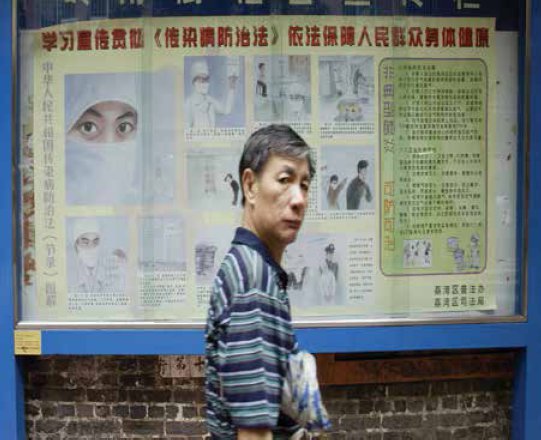
A man passes by a poster warning of the danger and prevention of SARS on a street in the southern Chinese cities of Guangzhou, 12 June 2003. (PETER PARKS/AFP/GETTY IMAGES)
In November 2003, WHO began hearing warnings from colleagues and credible internet sources of “a strange contagious disease” that was killing people in Guandong Province, which the authorities were trying to keep from the public. WHO formally requested more information from the Chinese government, but the government responded with a series of improbable denials and deflections. The Chinese government also refused to allow a WHO investigative team to visit the site of the outbreak or to share epidemiological data or viral samples with WHO.
WHO’s authority to respond to infectious disease outbreaks is laid out in an international treaty called the International Health Regulations (IHR). The version of the treaty that was in effect at the time only required governments to report to WHO cases of three specific diseases (cholera, plague, and yellow fever; not SARS), and only allowed WHO to notify the world about an outbreak based on information officially reported to it by Member State governments.
Brundtland determined that WHO’s response could not be limited by the IHR. As she later told the Guardian, “[i]f the job is to direct and coordinate global health, it’s not a question of what one or several governments ask you to do. We are working for humanity.” So the agency launched a “naming-and-shaming” campaign, going public with the information it received from unofficial (i.e. nongovernmental) sources and bringing international pressure to bear upon the Chinese government. WHO chided the Chinese government for withholding information, warning that it was putting the world at risk by delaying efforts to contain the virus. The agency also issued emergency travel advisories warning against travel to affected areas, doing so over the objections of those governments and even though issuing such warnings had previously been left up to individual countries.
As WHO spoke, governments and people listened. The Chinese government began to share information on the outbreak, as did other affected governments. Countries followed WHO’s guidance on how to contain outbreaks. These control efforts were a huge success. Although SARS spread to 26 countries, fewer than 1,000 people died, and the virus essentially disappeared.
The International Health Regulations 2005: new authority and old limitations
When the SARS outbreak occurred, Member State were in the process of revising the IHR. WHO was operating in a liminal space, and Brundtland and Heymann seized the opportunity to “test drive some very radical changes” in how the agency operated. In the end, in the new version of the treaty, Member States granted WHO many of the authorities and capacities that it had appropriated for itself during SARS, but also established strong, sovereignty-protecting guardrails limiting how WHO can exercise those authorities. In short, Member States’ feedback to WHO regarding the initiative shown during the SARS response was “good job; don’t do it again”.
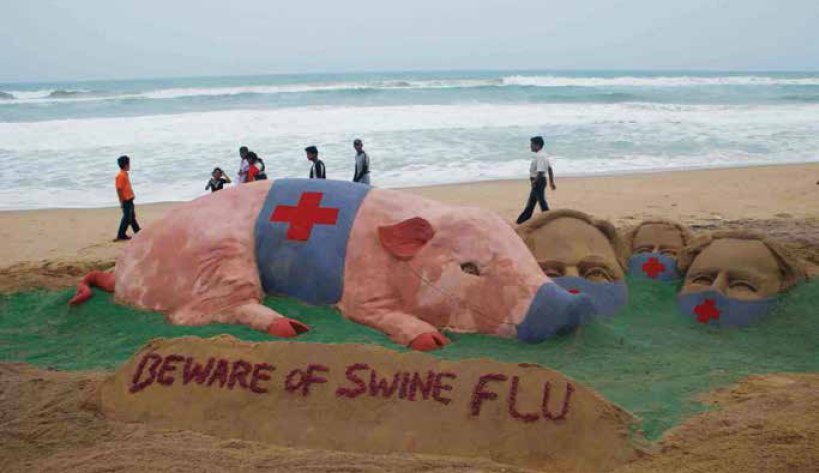
A sand sculpture of a mask-wearing pig by artist Sudersan Pattnaik decorates the beach Puri, about 65 km from the eastern Indian temple city of Bhubaneswar, on June 18, 2009. The swine flu virus, which was first detected in Mexico in April, has so far infected almost 30,000 people in 74 countries, killing about 150, according to the latest World Health Organisation figures. (AFP/GETTY IMAGES)
The IHR 2005 empowers WHO to declare a PHEIC to warn the world when there is a “serious, unusual or unexpected” health crisis “that poses a public health risk to other countries through international spread,” and also establishes WHO’s leadership role in coordinating the international response to such emergencies. Member States are required to notify WHO when there is a potential health emergency within their borders. Upon receiving such a report, the Director-General may summon an Emergency Committee of independent scientific experts to advise them on whether the reported outbreak constitutes a PHEIC. And in case a government once again tries to cover up an outbreak, the IHR authorize WHO to do what it did during SARS and take action based upon unofficial sources of information, like information obtained through WHO’s expert networks or credible media or social media reports. Since the IHR 2005 took effect, the agency has declared six PHEICs—for H1N1 in 2009; polio in 2014; Ebola in 2014 and 2018; Zika in 2015; and Covid-19 in 2020.
Once a PHEIC is declared, the Director-General, in consultation with the Emergency Committee, also issues recommendations about what measures should be taken to control the outbreak, including whether other countries should restrict trade or travel with outbreak-affected countries. The purpose of these recommendations is to ensure that the international response is based on science and data rather than panic and fear. In particular, one of the underlying principles of the IHR—as agreed upon by Member States—is that PHEIC response measures should “avoid unnecessary interference with international traffic and trade.” This is because trade and travel restrictions are usually imposed in such a way that they are ineffective at actually containing the spread of disease- but are economically damaging and can interfere with the public health responses. For example, travel restrictions imposed during SARS are estimated to have cost the Chinese and Canadian economies approximately $3 billion in lost tourism revenue. And during the spring of 2009, after H1N1 cases were first reported in Mexico, the Mexican economy lost $2.3 billion in trade revenue, even though WHO recommended against such restrictions. One danger is that if governments fear that reporting outbreaks will wreak havoc on their economies, they will be disincentivized from reporting in a timely manner.
However, although Member States were satisfied with WHO’s aggressive action to pressure the Chinese government during SARS, they were not so comfortable with the idea that they themselves might be subject to similar pressure in the future. Thus, even as governments granted WHO new powers, they also limited those powers to preserve their own sovereign prerogatives. For example, the experts who advise the Director-General on when to declare a PHEIC are nominated by governments And when the Emergency Committee meets, outbreak-affected governements have the opportunity to present (and presumably make a case for why a PHEIC should not be declared). Accounts reveal that one of the factors influencing Director-General Margaret Chan’s long delay in declaring the West African Ebola outbreak a PHEIC was resistance from the governments of Guinea, Liberia, and Sierra Leone.
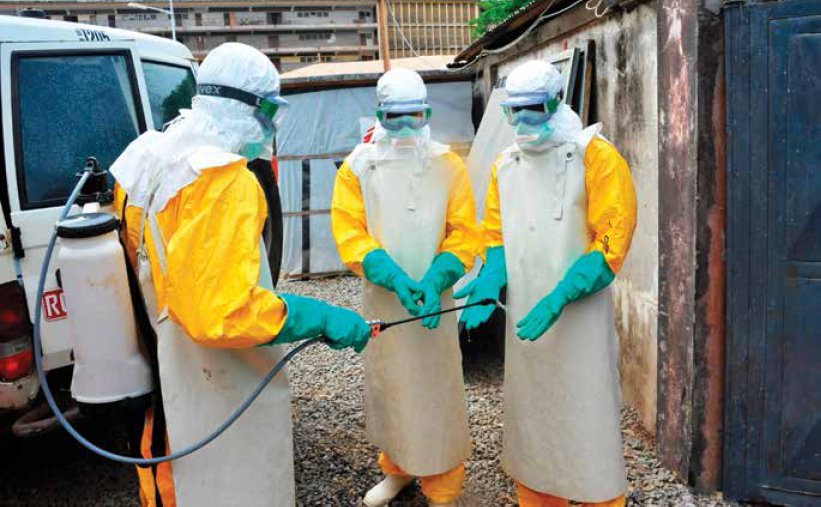
Medical staff clean their protection suits as part of the fight against the Ebola virus on March 8, 2015 at the Donka hospital in Conakry. More than 9,700 people have died of the disease since the west African epidemic emerged in southern Guinea in December 2013, with nearly 24,000 people infected, according to the World Health Organization.(CELLOU BINANI/AFP/GETTY IMAGES)
In addition, while WHO is authorized to take action and warn the world of outbreaks based on information from non-governmental sources, it must first seek to verify those reports with governments and offer to collaborate with them to control the outbreak. Only if affected governments refuse to share information and collaborate with WHO is the agency authorized to go public with information received from non-governmental sources. In other words, WHO can go around governments, but only after it has tried to go through them and been stonewalled.
Finally, the IHR 2005 has no teeth—the treaty itself offers Member States no incentives to comply, no disincentives for non-compliance, and gives WHO no enforcement mechanisms that can compel Member States to cooperate. For example, WHO consistently recommends against imposing trade and travel restrictions against affected countries, and governments consistently impose them regardless. Without any vinegar to hand, WHO has no choice but to secure governments’ cooperation through diplomatic honey. This limitation would critically hinder its response to Covid-19.
What has WHO done well and what could it have done differently? The Covid-19 response
On December 31, 2019, WHO picked up reports through non-governmental channels of cases of “viral pneumonia of unknown cause” in Wuhan, China. Following the process laid out in the IHR, the agency requested more information from the Chinese government and activated its emergency response team and global partner network. On January 3, 2020, Chinese officials formally notified WHO of the first outbreak of the disease that would be called Covid-19. Over the next two days, WHO publicly announced the outbreak on Twitter and through official channels and shared the first scientific report with governments. On January 9, WHO reported that Chinese scientists had determined that the illness was caused by a novel coronavirus (first called 2019-nCov, later named SARS-CoV-2). And on Jan 10, after convening the first of many international scientific expert consultations, WHO issued the first set of technical guidance for countries on how to prepare for and respond to the outbreak.
They were also trying to obtain an invitation from the Chinese government to send an international team of experts to assess the situation on the ground. Behind the scenes, the Secretariat was furiously pressing the Chinese government to share more information—including more detailed epidemiological data on cases (needed to assess the virus’ lethality and potential for human-to-human transmission), the virus’ genome (needed to develop diagnostic tests),
The Chinese government was communicative but also cagey, putting WHO in a difficult situation. On January 12, China shared the virus’ genome with WHO—on the same day that Chinese scientists published that genome in a scientific journal. The world later learned that China had delayed sharing the genome and also had known that the outbreak was caused by a coronavirus weeks before it shared this information with WHO. These delays were driven by a combination of authoritarian opacity, internal political pressures and bureaucratic dysfunction within China.
China’s delayed and non-transparent information sharing also complicated WHO’s attempts to communicate risk to the public. In a January 14 press conference, Dr. Maria Van Kerkhove, WHO’s technical lead for the Covid-19 response, raised the prospect of human-to-human transmission, saying that “it is possible, we need to prepare ourselves.” On the same day, Chinese health officials apprised the government that human-to-human transmission was likely occurring. But publicly, China was still denying that possibility, forcing WHO to backtrack. Attempting to clarify, the agency tweeted that “preliminary investigations conducted by the Chinese authorities have found no clear evidence of human-to-human transmission.” (The key word missing from the end of that that tweet was “yet.”) This tweet would later come back to haunt the agency, with critics using it as evidence that WHO was assisting the Chinese government to cover up the severity of the epidemic. It wasn’t until January 19/20, when the WHO Representative in China visited Wuhan, that the Chinese government publicly confirmed that human-to-human transmission was occurring and asked for WHO’s assistance “in communicating this to the public, without causing panic.”
By the third week of January, 575 cases had been reported in China, and 9 cases outside China (in Hong Kong, Taiwan, Thailand, Japan, Singapore, South Korea, Vietnam, and the U.S.). On January 22, WHO convened an Emergency Committee to advise Tedros on whether to declare a PHEIC. The Committee deliberated for two days but was split. Members agreed that the situation was urgent, but some felt that the available information was too limited and the number of cases outside China too few to warrant a PHEIC declaration, which is the highest level of alarm that WHO can ring. (Critics have questioned why WHO did not label Covid-19 a “pandemic” until March 11; however, the term pandemic is a colloquial one, with no set definition and no formal legal or policy significance.) In the end, the Committee recommended against declaring a PHEIC for the moment, awaiting more information, and agreed to reconvene in ten days’ time (or earlier, if necessary). Meanwhile, on the same day, China imposed a cordon sanitaire around the city of Wuhan, population 11 million; eventually, the cordon would encompass some 60 million people, the largest in history.
On January 28, Tedros took the “highly unusual” step of flying to China to meet with President Xi and plead with China to share information more quickly and transparently. Xi also agreed to allow an international team to visit China and assess the situation-though his government later stalled and did not allow the team’s visit until the middle of February. On January 29, in response to the rapidly growing number of cases inside China and evidence of sustained human-to-human transmission outside China, Tedros decided to reconvene the Emergency Committee. On January 30, based on their recommendation, he declared a PHEIC.
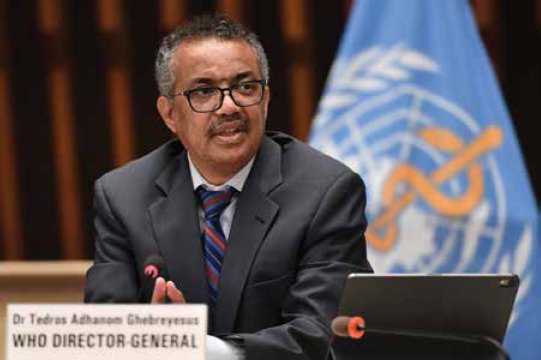
World Health Organization (WHO) Director-General Tedros Adhanom Ghebreyesus attends a press conference organised by the Geneva Association of United Nations Correspondents (ACANU) amid the COVID-19 outbreak, caused by the novel coronavirus, on July 3, 2020 at the WHO headquarters in Geneva. ( FABRICE COFFRINI/AFP/GETTY IMAGES)
Public praise, private frustration
Months later, it is clear that, in the words of one Emergency Committee member, China “misled” WHO and the world about the extent of the Wuhan outbreak. Had Chinese officials at every level of government shared information more quickly and transparently, there is a chance that the Covid-19 could have been contained before it became a global pandemic. (Though it is equally true that if other governments, including the U.S., had acted with greater urgency in February and March, Covid-19 might not have exploded into a pandemic.)
Critically, WHO sensed it was being stonewalled. Internal communications obtained by the AP reveal top officials’ frustration with China. At one point, Maria Van Kerkhove wrote “We’re going on very minimal information…It’s clearly not enough [] to do proper planning.” Dr. Gauden Galea, the WHO Representative in China, complained that “We have informally and formally been requesting more epidemiological information….But when asked for specifics, we could get nothing” and “We’re currently at the stage where yes, they’re giving [information] to us 15 minutes before it appears on [Chinese state television].” And in early January, Dr. Mike Ryan, the Executive Director of the Health Emergencies Program, warned colleagues that “it was time to ‘shift gears’ and apply more pressure on China…‘This is exactly the same scenario, endlessly trying to get updates from China about what was going on.’” Unfortunately though, there was no way for WHO to ascertain the extent to which it was being misled. Unlike the IAEA, for example, it has no independent investigative authority to send teams into a country absent an invitation from the government.
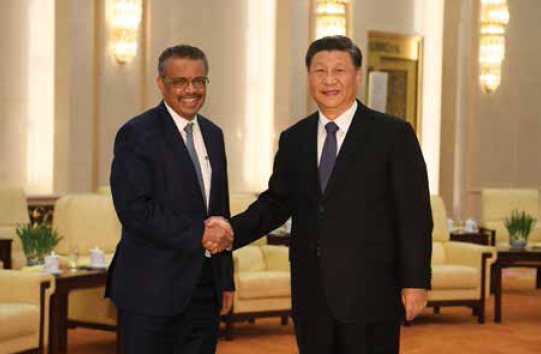
Tedros Adhanom, Director General of the World Health Organization, (L) shakes hands with Chinese President Xi Jinping before a meeting at the Great Hall of the People, on January 28, 2020 in Beijing, China. (NAOHIKO HATTA/POOL/GETTY IMAGES)
And yet, all the while, WHO was publicly praising the Chinese government for its response to Covid-19, including its information sharing. For example, on January 30, Tedros said “The speed with which China detected the outbreak, isolated the virus, sequenced the genome and shared it with WHO and the world are very impressive, and beyond words. So is China’s commitment to transparency and to supporting other countries.” Simultaneously, WHO was also warning of the urgency of the situation—which is, after all, the point of issuing a PHEIC declaration—and pressing governments to “act now” to prepare. But is it probably fair to say that WHO’s praise for China’s response contributed to a false sense of reassurance that things were under control (or, at least, heading in that direction).
Why did WHO, through its lavish praise, paint a misleading picture of China’s cooperation and transparency? Critics, including the Trump administration, assert that it is because WHO’s leadership is beholden to and under the thumb of the powerful Chinese government. In Trump’s words, WHO therefore “willingly took China’s assurances at face value and defended the actions of the Chinese government.” But this explanation doesn’t quite stand up to scrutiny. China’s influence at WHO is growing, but it is still far less influential than the U.S. In a moment of unexpected candor, Tedros essentially admitted as much, saying “It is wrong to be any ‘country-centric.’ I am sure we are not China-centric. The truth is, if we are going to be blamed, it is right to blame us for being U.S.-centric.” The U.S. is WHO’s single largest donor. In 2018–19, it contributed 15% of WHO’s budget; in contrast, China contributed 1.5%—and only 0.2% came in the form of voluntary contributions, which China could withdraw should it so choose. It is also inaccurate to suggest that WHO simply bowed to pressure from the Chinese government. For example, at one point, China wanted to sign off before WHO passed information received from the Chinese government on to other countries; WHO refused.
Rather, WHO’s gratuitous praise of China was a strategic gambit to coax the Chinese government into cooperating with WHO, sharing information, and allowing international expert investigators into the country. In short, WHO was trying to win China over with honey and they slathered it on too thickly. The strategy was dicey—ultimately, it clearly undermined WHO’s credibility and cost it the support of its largest donor (if temporarily).
But, apart from toning down the laudatory rhetoric, it’s not entirely clear what Tedros could have done differently. Anthony Costello, the director of the UCL Institute for Global Health and a former director at WHO, told the Guardian, “I don’t think Tedros did anything previous director generals would not have done. He needed a good relationship with China in order to get in.”
Why didn’t Tedros attempt to name-and-shame China, as Brundtland had during SARS? Apart from their different leadership styles, such a maneuver would have been far more difficult to manage now than it was in 2003. For one thing, WHO felt that it was in a legal grey area. China was not sharing information fully and transparently, but it neither was it denying the outbreak or refusing to cooperate with WHO. Under the latter circumstances, the IHR empower WHO to publicize countries’ non-compliance. But in this case, WHO officials felt that “since China was providing the minimal information required by international law, there was little WHO could do.” Second, if the Secretariat antagonized China, they ran the risk of losing access complete. The Chinese government could stop sharing information altogether and then WHO would have no choice but to name-and-shame and hope to generate enough international pressure to induce the Chinese government to reverse course. At worst, this strategy might have been unsuccessful—China has far more international clout than it did 2003. And even if it did work, it would have taken time—time that the world did not have if it wanted to contain the virus.
In short, as one European diplomat put it, WHO’s praise for China “was a tactical decision, and it was probably the only way to get access. But the optics are uncomfortable.” The New York Times editorial board offered a more pointed analysis: “[The IHR] are effectively unenforceable. Individual countries routinely violate the edicts that don’t suit them, and the WHO has almost no recourse when that happens. If the organization had more sticks to wield—if there were penalties for defying its previously agreed-upon rules—it might not have to meet the duplicity and delay it sometimes encounters with so much patient praise.”
What else is WHO doing?
Since the earliest days of the pandemic, WHO has been frenetically active in its efforts to stimulate country preparedness and coordinate a global response to the pandemic. These efforts can be broken down into four streams: information sharing and technical guidance; capacity strengthening, particularly for low and middle income countries (LMICs); fundraising to support the global response; and high-quality research and development, and equitable distribution, for diagnostics, therapeutics and vaccines. On many fronts, WHO’s efforts have been success and innovative. But there are also areas in which the agency has struggled, revealing both the internal challenges and external obstacles that limit its effectiveness.
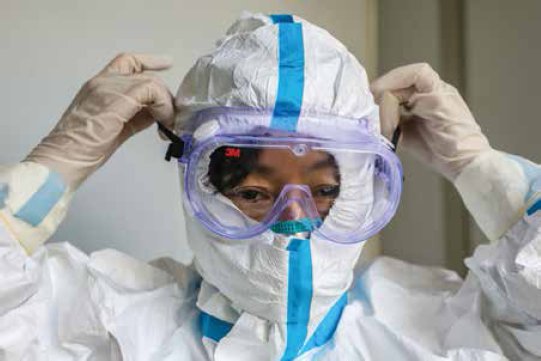
This photo taken on January 30, 2020 shows a doctor putting on a pair of protective glasses before entering the isolation ward at a hospital in Wuhan in China’s central Hubei province, during the virus outbreak in the city. (AFP/GETTY IMAGES)
Information Sharing and Technical Guidance
First and foremost, WHO’s role in a pandemic is to share information—to gather, analyze, and publish epidemiological data; disseminate scientific finds and public health best practices/lessons learned; issue technical guidance, and combat the spread of misinformation. WHO’s information sharing efforts and output are unprecedented in volume. From the outset, WHO has urged governments to transparently share data on cases and deaths, rather than try to hide the extent of the epidemic in their countries. On the whole (after China’s early delays), they have been remarkably successful WHO’s data dashboard publicly displays daily case-counts for nearly all WHO Member States, including from countries in the Middle East, Africa, and Latin America that are often reluctant to publicize data.
WHO holds near-daily press briefings and #AskWHO public Q&A sessions on social media. They host weekly meetings in which governments share their experiences and best practices/lessons learned. In the first seven months of the pandemic, WHO issued 125 technical guidance documents, informed over 60 expert consultations and webinars with over 13,5000 participants from more than 120 countries. This guidance covers everything from virus transmission, social distancing, testing, contract tracing, quarantine and isolation, personal protective equipment for community members and health workers, and much more. WHO is also working with major social tech companies like Facebook, Google, and WhatsApp to combat the spread of Covid-19 misinformation.
For the most part, this guidance has been well-received by governments, scientists, and the public. That said, WHO’s communications efforts have not been without mishaps. The reversals around human-to-human transmission is one example. Another is the kerfuffle over “asymptomatic” transmission, a miscommunication that boiled down to differences in the technical vs. colloquial meaning of the term. WHO quickly clarified these comments, but they nonetheless contributed to public confusion at a time when we can ill-afford it. Communicating complex scientific information to the public and maintaining an authoritative voice in an environment of high uncertainty and rapidly evolving knowledge is no easy task. Miscommunications happen, but the important thing is that WHO has moved quickly to correct those mistakes.
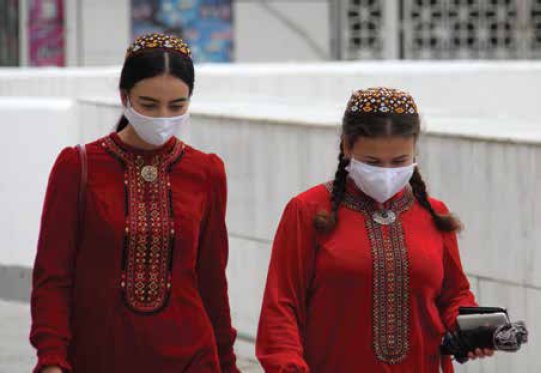
Women wearing protective face masks, used as a preventive measure against the spread of the coronavirus disease (Covid-19), walk along the street in Ashgabat, Turkmenistan July 13, 2020. (VYACHESLAV SARKISYAN/REUTERS/NEWSCOM)
The more troubling criticism of WHO’s technical response to Covid-19 is that the agency’s internal experts, and the independent external experts who sit on its scientific advisory committees, have been too slow to integrate new findings about how Covid-19 may be spread—i.e. the possibility of transmission through small, aerosolized particles rather than large respiratory droplets—and too conservative in updating their guidance. The possibility of aerosol transmission has significant, urgent implications for the protective measures we take, particularly indoors (e.g. ventilation standards). Critics argue that WHO is stuck in old orthodoxies, keeps moving the goal posts on what type of data would be needed to accept aerosol transmission, and has been unwilling to embrace the precautionary principle and encourage governments, businesses, and individuals to act as if aerosol transmission might be happening and take the necessary precautions. In July, a group of over 200 scientists published a commentary in Clinical Infectious Diseases urging WHO to reconsider the evidence. WHO did so and half-heartedly conceded that the possibility “cannot be ruled out,” but emphasized other modes of transmission (droplets, fomites) and did not issue proactive new guidance. The guidance has since been updated, but critics continue to argue that WHO is not giving aerosol transmission the urgent emphasis and clear public messaging needed.
WHO was similarly slow to act in advising the public to wear masks. For many months, WHO advised against mask-wearing by non-symptomatic individuals, even in the face of growing evidence about pre-symptomatic/asymptomatic transmission. WHO officials were concerned that masks would give people a false sense of security and lead them to neglect other prevention measures like social distancing and hand washing. They also worried that mask-wearing by the general public would further strain the already-limited supply of masks for healthcare workers and about affordability for low-income individuals and countries. By the time WHO finally did recommend mask wearing in early June, around 100 countries—including many low-income countries—had already adopted some form of mask mandate.
Capacity Building and Fundraising
The second and third streams of WHO’s work focuses on marshalling capacity and resources for the global Covid response, and in particular, supporting LMICs. As of mid-August, WHO had shipped over 100 million masks and tens of millions of other pieces of personal protective equipment to 148 countries. They distributed crucial medical equipment and diagnostics, including over 18.2 million respirators and over 11,700 oxygen concentrators, and over 6 million test kits and swabs. The agency also provides free digital resources for over 70,000 health care workers in over 200 countries and has deployed 180 Emergency Medical Teams to assist with countries’ responses on the ground.
Unfortunately, but perhaps not surprisingly, the perennially-underfunded agency has had to struggle to secure financial support for its work. In February, the agency appealed to donors for $675 million to finance its preparedness and response work through April. According to the Guardian, by the first week in March, they had received only $1.2m. The funding target wasn’t reached until early April, at which time there were already one million cases worldwide. The agency then had to issue a second funding request for $1.7 billion to carry it through December 2020; as of mid-August, the agency had received 52% of this money, with another 29% pledged, and a funding gap of $330 million.
But necessity has also served as the mother of invention. In March, WHO launched the Covid-19 Solidarity Response Fund which, for the first time, enables WHO to raise money directly from the general public. At time of writing, the Fund had raised over $233 million from more than 566,000 individuals, companies, and philanthropies worldwide, including $55 million raised from a benefit concert hosted by Lady Gaga.
Research, Development, and Distribution
WHO’s fourth stream of work focuses on advancing research and development for Covid-19 diagnostics, treatments, and vaccines, and on ensuring that these vaccines are allocated equitably across all countries. For example, WHO coordinated the Solidarity Trial, an international clinic trial to identify effective Covid-19 treatments.
In addition, WHO is coordinating the Access to Covid-19 Tools (ACT) Accelerator, a massive collaboration among governments, global health organizations (like Gavi, the Global Fund to Fight AIDS Tuberculosis and Malaria, and the Coalition for Epidemic Preparedness (CEPI)), researchers, civil society, and philanthropists (like the Gates Foundation and the Well-come Trust). Its goal is to speed up research, production and equitable distribution of vaccines, treatments, and diagnostics and to prepare health systems to roll out these tools.
One of the most critical components of this framework is the COVAX Facility, Countries can sign up to purchase vaccines through this pooled procurement mechanism, which will works with manufacturers of various vaccine to negotiate prices, expand vaccines production, use funding from high-income countries to subsidize vaccine purchases for LMICs, and ensure that vaccines doses are distributed equitably to high-risk populations and essential workers across all countries. Equitable distribution is essential both from an ethical perspective, and because countries will not be able to fully reopen their economies to trade and travel until the virus is controlled globally. The pandemic will not be over anywhere until it is over everywhere. The alternative to global coordination through COVAX is “vaccine nationalism”—an “every country for itself” approach in which countries must purchase their own vaccine supplies, negotiate their own prices, gamble on which vaccine candidates are likely to be most effective, and run the risk of being shut out due to supply shortages and geopolitical competition. This approach would have devastating consequences for people in countries that cannot afford to make massive advance purchases of multiple vaccines. If wealthy countries choose to hoard vaccine doses, as occurred during the 2009 H1N1 pandemic, the rest of the world would effectively be sent to the back of the line, and even those at highest risk would have to wait until the entire population of wealthy countries is vaccinated before they could get their shot.
WHO, Gavi, and CEPI established the COVAX Facility to prevent this scenario. But although a number of wealthy governments—including much of Europe and the UK—initially signed on to the idea and contributed funding, they proceeded to hedge on their commitment and have struck separate deals with vaccine companies to secure their own supplies. For instance, the UK pre-ordered five vaccine doses per person (of different vaccines). And like WHO as a whole, the ACT Accelerator has struggled to secure funding: as of late June, it had raised only $3.4 billion of its $31.3 billion ask, and $13.7 billion of this shortfall was considered urgent.
This situation typifies one of WHO’s chief limitations. The agency is expected to act as the leading and coordinating authority in global health. But as in any orchestra, the conductor can only be as effective as the orchestra members allow them to be. If the orchestra members—the Member States—are willing to be coordinated to play along together, the result is beautiful music. If not, there is only discord, and WHO stands alone waving a baton to no avail. The decision rests with the Member States.
Where do we go from here? WHO reform
So where does WHO go from here? Member States have already initiated a review process to evaluate WHO’s Covid-19 response and are discussing how to reform the agency to address some of the internal challenges and external limitations it laid bare. This is not the first time a PHEIC has triggered this kind of performance review and reform process—H1N1 and the West African Ebola epidemic did too. But this is the first time that such a review has occurred while the PHEIC was ongoing. And it is the first time since SARS that Member States have opened the door to revising the IHR—and their own commitments and obligations under it—rather than focusing purely on the Secretariat’s performance.
Countries, including Australia, France, Germany, and the U.S, have begun to put forward concrete proposals for what reforms might look like. For example, a non-paper (informal discussion paper) circulated by the German and French governments, states “The international community’s expectations regarding WHO’s capacities outweigh by far its given financial, structural and legal abilities…. Covid-19 has to be used as an opportunity to strengthen WHO’s abilities to fully act as the leading and coordinating authority in global health. Long-term strengthening of WHO overall is key in order to strengthen its role and responsibilities in pandemic preparedness and response.” A Western diplomat based in Geneva told Reuters that “The [non-paper’s] key point is the mismatch between WHO’s mandate and financing. It’s very much pro-WHO, it should have more money and [they are] asking for an increase in assessed contributions.”
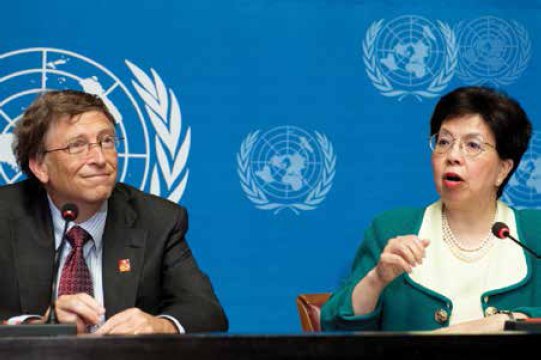
Margaret Chan (right), Director-General of the World Health Organization with Bill Gates, Co-Chair of the Bill & Melinda Gates Foundation, at a press conference during the 64th World Health Assemlby in Geneva, Switzerland, May 17, 2011. Bill Gates challenged health ministers and global health leaders to make vaccines their top priority to save millions of lives. (JEAN-MARC FERRÉ/UN PHOTO)
Problems to be solved
The Franco-German and Australian reform proposals—as well as proposals from independent global health experts—identify two overarching sets of problems that need to be addressed in order to have meaningful WHO reform. First are the institutional problems. Chronic underfunding and unsustainable funding leaves WHO without capacity to get the job done and makes it dependent on and subject to undue influence by donors (or, at least, creates the appearance that it is subject to undue influence). This precarious funding—coupled with the deference to sovereignty that Member States demand—mean that WHO lacks the political independence to respond proactively and decisively to health emergencies or otherwise safeguard global health as a global public good. As a group of leading experts write in the Lancet, “WHO must evolve to become more results-oriented and responsive. Such an evolution requires more than a functional review: it calls for a thorough transformation that overcomes political divisions and empowers WHO with the ability to question and constructively criticize national health strategies. We call for a WHO whose technical authority is fully recognized by Member States and is free of political considerations.”
Second are the design weaknesses within the IHR themselves. For one thing, the PHEIC designation is a binary construct—the Director-General can either not declare an emergency or declare the highest level of emergency. This all-or-nothing approach does not lend itself to the kind of early warning system we need. When Director-General Margaret Chan acted swiftly to declare a PHEIC for H1N1 and the crisis turned out not to be as severe as expected, she was accused of “crying wolf” and undermining WHO’s credibility. Tedros, on the advice of the Emergency Committee, held off declaring a PHEIC for a week in order to gather more information, and has been criticized for not acting swiftly enough.
Another issue is the lack of investigative and enforcement authority granted to WHO under the IHR. When the Chinese government spent weeks stringing the agency along, WHO officials had no authority to compel their cooperation and no ability to assess the situation independently. When governments fail in the obligation to inform WHO of possible PHEICs in a timely and transparent manner, or when they implement response measures in contravention of the IHR, WHO and other Member States have no mechanism to enforce the terms of the treaty or hold governments accountable for non-compliance.
WHO doesn’t just lack sticks, it also lacks carrots. After the West African Ebola outbreak, Member States created the Contingency Fund for Emergency, a pot of money that WHO could dispense to help countries immediately respond to potential health emergencies. This was supposed to incentivize countries to report outbreaks in timely manner in order to receive funding. But the fund has been chronically underfunded and, in addition, is of no help when the outbreak occurs in a country like China that does not need financial or technical support from WHO.
Possible solutions
The reform proposals on the table go some way toward addressing these problems. For example, the Franco-German non-paper calls on Member States to consider increasing assessed contributions, or at least to shift to non-earmarked voluntary contributions that give WHO the budgetary flexibility to meet pressing needs. It also suggests shifting from a binary PHEIC declaration to a stoplight-type warning system. The Australian government proposed independent investigative authority (along the lines of IAEA weapons inspectors), which the German and French governments also support.
But in other respects, the proposed reforms may not go far enough, or may ever veer off in the opposite direction. While the non-paper mentions the need to strengthen Member States’ accountability under the IHR, it stops short of proposing concrete enforcement mechanisms (along the lines of the WTO enforcement mechanism), which might infringe on countries’ sovereign prerogatives. (In fact, it does not even use the term “enforcement.”) Nor do we know whether Member States will ultimately be willing to lift other sovereignty-preserving guardrails in the IHR, such as allowing WHO to issue public warnings about potential emergencies based on information from unofficial sources without verification by governments.
The Australian, German, and French governments also discuss creating new oversight mechanisms to monitor WHO’s handling of emergency responses. But it is not clear how these new mechanisms would fit the with existing mechanisms, such as the WHO Health Emergencies Program’s Independent Oversight and Advisory Committee or the independent Global Preparedness Monitoring Board. Thus, this particular proposal risks stumbling into familiar dangers: the creation of new committees substitutes for meaningful action, and duplication and fragmentation of accountability mechanisms distracts from, rather than enhances, real accountability. In addition, the Franco-German non-paper emphasizes the need for Member States themselves to “provide adequate oversight and guidance to WHO’s work in health emergencies” and suggest the creation of a sub-committee of the Executive Board for this purpose. However, one of the biggest criticisms of WHO’s response to Covid-19 is that the Secretariat is too deferential to Member States and lacks the political independence it needs to do its job. It hard to see how more-intensive oversight by governments would enhance WHO’s political independence.
Finally, the reform proposals advanced by Member States thus far do not address one of the most important internal limitations apparent in WHO’s Covid-19 response: the non-transparency of the PHEIC decision-making process and the lack of diverse expertise informing the agency’s decision-making. WHO’s experts—both the Secretariat staff and external experts it consults, such as EC members—are primarily doctors and biomedical scientists (epidemiologists, virologists, etc.) However, the decisions that these experts take when advising on whether to declare a PHEIC or formulating recommendations and technical guidance, are inherently political decisions with far-reaching economic, social, diplomatic, and legal implications. Although the Emergency Committee’s deliberations take place behind closed doors, Committee members have revealed that these implications do influence their decisions. Rather than expecting epidemiologists to assess economic and political impacts, the PHEIC process could be improved by including more diverse expertise. Consulting a wider range of expert voices might also help address criticisms that the agency is too slow and orthodox in updating its technical guidance.
Conclusion
WHO’s response to Covid-19 is the most robust response to a public health emergency that the agency has launched since SARS. But it has also engendered much criticism of the Director-General and the Secretariat. Some of this criticism is fair. Some is less fair, because it effectively blames the agency for not doing things that it is not empowered to do. The fundamental dilemma of WHO’s performance during Covid-19 and across the board is this: Member States get what they pay for and they get what they order, but they do not magically get what they need. Governments demand deference from WHO, and for decades, they have not provided it with adequate funding to do its job. Except when an emergency arises, they want an agency that provides behind-the-scenes technical advice and support, but that does not step on their sovereignty or publicly challenge their actions. This is the agency they have built. But when an emergency arises, governments’ desires shift—they suddenly want an agency that is strong and independent, capable of compelling recalcitrant governments and stopping outbreaks in their tracks. Unfortunately, we do not live in a comic book world where mild-mannered scientist Bruce Banner is capable of transforming into the Incredible Hulk in the face of danger.
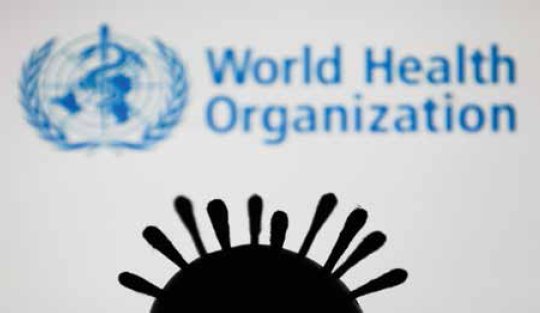
Coronavirus model is seen with World Health Organization (WHO) logo in the background in this illustration photo taken in Poland on June 5, 2020. (JAKUB PORZYCKI/NURPHOTO/GETTY IMAGES)
The prospects for meaningful WHO reform hinge entirely on whether Member States are willing to change what they order and what they pay for. It is easy and convenient for governments to depict WHO as a dysfunctional bureaucracy trying to execute a political two-step on the head of a pin. But as the New York Times editorial board writes, “Instead, [governments] should try seeing WHO for what it is: a reflection of the countries that created it and that wrote its bylaws. If they don’t like what they see, they should work to improve that reflection.”
discussion questions
1. Should the U.S. continue their plan to exit the WHO by July 2021? If the U.S. does shift course and stay in the WHO, what changes would be most important to implement first?
2. Do you agree with the proposals promoted in the “non-white paper” on how to improve the WHO? What are some changes you would add or take out of the proposal?
3. How much control should international organizations have over their member countries? Should organizations like the UN and WHO have authority to overstep local governments?
4. Should the main function of the WHO be to prevent any future global outbreaks like covid-19, or is it better for the organization to have multiple different interests?
5. What would be some of the drawbacks, if any, to increasing the role and authority of most international organizations?
suggested readings
Mandavilli, Apoorva. 239 Experts with One Big Claim: The Coronavirus is Airborne, New York Time, July 4, 2020.
Chorev, Nitsan. The World Health Organization between North and South, 288 pg. Cornell University Press, 2012. Chorev assesses the response of the WHO bureaucracy to member-state pressure in two particularly contentious moments: when during the 1970s and early 1980s developing countries forcefully called for a more equal international economic order, and when in the 1990s the United States and other wealthy countries demanded international organizations adopt neoliberal economic reforms.
Government of France & Government of Germany. 2020. “Non-Paper on Strengthening WHO’s Leading and Coordinating Role in Global Health.” August 2020.
Cueto, Marcos, Brown, Theodore M. and Fee, Elizabeth. The World Health Organization: A History 388 pg. Cambridge University Press, 2019. The authors re-evaluate the relative success and failure of critical WHO campaigns, from early malaria and smallpox eradication programs to struggles with Ebola today.
Kamradt-Scott, Adam. Managing Global Health Security: The World Health Organization and Disease Outbreak Control 244 pg. Palgrave Macmillan, 2015. Drawing on insights from international organization and securitization theory, the author investigates the World Health Organization and how its approach to global health security has changed and adapted since its creation in 1948. He also examines the organization’s prospects for managing global health security now and into the future.
O’Neill Institute for National & Global Health Law, “The WHO Explained”. Georgetown Law. https://oneill.law.georgetown.edu/the-who-explained/Ger
Don’t forget: Ballots start on page 104!!!!
To access web links to these readings, as well as links to global discussion questions, shorter readings and suggested web sites,
GO TO www.fpa.org/great_decisions
and click on the topic under Resources, on the right-hand side of the page.